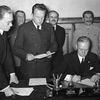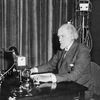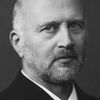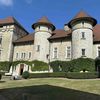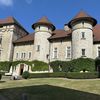6.2.2012 | 10:31
Grein um kommúnisma í Grapevine
From Copenhagen, via Moscov and Reykjavik, to Havana
Twists and Turns in the History of the Icelandic Communist Movement
 The Icelandic communist movement started earlier, had closer ties with the Kremlin, was more influential, and lasted longer, than has previously been fully recognized. These are the main conclusions of my book, Islenskir kommunistar 1918–1998 (Icelandic Communists, 1918–1998), published in the autumn of 2011 and already provoking heated debate amongst Icelandic historians.
The Icelandic communist movement started earlier, had closer ties with the Kremlin, was more influential, and lasted longer, than has previously been fully recognized. These are the main conclusions of my book, Islenskir kommunistar 1918–1998 (Icelandic Communists, 1918–1998), published in the autumn of 2011 and already provoking heated debate amongst Icelandic historians.
The origin of the Icelandic communist movement can be traced back to November 1918 when two Icelandic students at Copenhagen University, Brynjolfur Bjarnason and Hendrik S. Ottosson, participated in a street riot in Copenhagen, and became political radicals. They got into contact with the main Soviet agent then in the Nordic countries, the Swedish Fredrik Ström, who sponsored their trip to the 2nd Comintern congress in Moscow in 1920. There they heard Vladimir Lenin comment on the strategic importance of Iceland in a coming war in the North Atlantic; they also received some funds to use for propaganda in Iceland. In Moscow the two young Icelanders met some future leaders of the international communist movement, such as the famous German propaganda master Willi Münzenberg, from whom Goebbels later learned a lot.
In the next few years a small, but determined, communist nucleus—consisting mostly of young intellectuals who had studied in Denmark and Germany—formed in Iceland, becoming the radical wing of the Social Democratic Party. Those communists had close ties to Comintern, sending representatives to all its congresses, not only in 1920, but also in 1921, 1922, 1924 and 1928. Moreover, Comintern sent agents to Iceland to help organize a communist party: Olav Vegheim in 1925, Hugo Sillén in 1928 and 1930, and Haavard Langseth, Harry Levin and (possibly) Viggo Hansteen in 1930. Finally, the Icelandic Communist Party was established in November 1930 with Brynjolfur Bjarnason as its chairman. During the Depression, the communists organized various violent clashes with the police, mostly in connection with labour disputes. A Comintern agent, Willi Mielenz, was sent to Iceland in 1932, probably to advise on illegal activity (which had been his specialty in the German Communist Party). The Icelandic communists even organized a fighting force, modelled on the German Rot Front (Red Front, the Communist fighting force), and sent around 20 Icelanders for revolutionary training in Moscow. One of those trainees, Hallgrimur Hallgrimsson, later fought in the Spanish Civil War.
Archives in Moscow reveal that the Icelandic Communist Party was closely monitored and financially supported by Comintern, by then tightly controlled by Stalin and his clique. The Party faithfully followed the changing directives from Moscow, fighting against Social Democrats as “social fascists” until 1934, but trying to establish a “United Front” with them after that. Unlike its counterparts in other Western European countries, it succeeded in luring some leading Social Democrats into its camp, and in October 1938, the Socialist Unity Party was established. Its first chairman was the Social Democrat Hedinn Valdimarsson, but the communists controlled the party, as became obvious in 1939, when Hedinn Valdimarsson and some of his followers left in disgust over the communists’ unwavering support of Stalin’s politics. The communist Einar Olgeirsson then became chairman of the Socialist Unity Party.
The close ties with Moscow remained. Leading members of the Socialist Unity Party, such as Kristinn E. Andresson and Einar Olgeirsson, went to Moscow, gave reports and received advice (and money). The Party also towed the Soviet line in international affairs, defending the notorious show trials in Eastern Europe and the communist invasion of South Korea. The socialists staged violent demonstrations in the spring of 1949, when Iceland joined NATO. Archives in Moscow reveal that in the 1950s and 1960s, the Socialist Unity Party received substantial financial support directly from the Soviet Communist Party, and important assistance from it and from other communist parties in Central Europe, in particular the East German Socialist Unity Party, SED. Needless to say, this was kept strictly secret. The only example I have found of the Socialist Unity Party not adhering to the Moscow line was that it refused to condemn those communist parties which had fallen out with the Kremlin leaders, such as the Yugoslavian party in the late 1940s, and later the Albanian and Chinese parties.
After the 1968 Soviet invasion of Czechoslovakia, those Icelandic socialists who wanted to sever ties with Moscow, gained the upper hand in the Socialist Unity Party. In the autumn of 1968 the People’s Alliance (which had previously existed as a loose electoral alliance) began to operate as a party, while the Socialist Unity Party was disbanded. The considerable properties that the Socialist Unity Party had accumulated, most likely with Soviet money, remained in the hands of the old leadership of the Socialist Unity Party, but were later sold to solve a financial crisis in the People’s Alliance. Some leading members of the People’s Alliance, including Ludvik Josepsson (chairman 1977–80) and Svavar Gestsson (chairman 1980–87) , discreetly maintained ties to the Soviet Union, for example in visits to Moscow. Svavar Gestsson had attended a special cadre school in East Berlin 1967–68, Institut für Gesellschaftswissenschaften bei ZK der SED (the Institute for Social Sciences of the Central Committee of the Socialist Unity Party), supposed to be the highest educational institution for the country’s communist elite. After 1968, however, Svavar Gestsson and other leading socialists increasingly turned to Ceausescu’s Roumania and Castro’s Cuba for inspiration.
During its lifetime, 1938 and 1968, the Socialist Unity Party was stronger than its counterparts in most other Western European countries. It received, for example, 19.5% of the votes in 1949 and 16% in 1953. Its chairman to the end, Einar Olgeirsson, remained a staunch supporter of the Soviet regime. The People’s Alliance, mostly controlled by the socialists, participated four times in government during the Cold War, 1956–58, 1971–74, 1978–1979, and 1980–1983, and some of its ministers were old Stalinists, including Ludvik Josepsson and Magnus Kjartansson, neither of whom ever repented publicly. The Icelandic socialists were also very influential both in the labour movement and in Icelandic cultural life (partly, as the Moscow archives show, due to generous support from the Soviet Union).
While the Socialist Unity Party was in effect a communist party, the same cannot be said about the People’s Alliance which operated as a party between 1968 and 1998. However, many in the People’s Alliance had sympathy with the communist states. Some of my left-wing colleagues at the University of Iceland even volunteered to harvest sugar cane in Cuba in the 1980s, proudly defending the oppressive communist regime there. Significantly, also, the last act of the People’s Alliance, in November 1998, was to accept an invitation from the Cuban Communist Party. The Icelandic delegation to Cuba included the former chairman, Svavar Gestsson, and the last chairman, Margret Frimannsdottir (chairman from 1995). The Icelandic political pilgrims had hopes of seeing the dictator, Fidel Castro, who did not however bother to receive them. Thus, the history of the Icelandic communist movement ended, in the poet’s words, not with a bang, but with a whimper.
(Ţessi grein birtist, stytt, í 2. tbl. Grapevine 2012.)
Flokkur: Stjórnmál og samfélag | Breytt s.d. kl. 10:36 | Facebook




